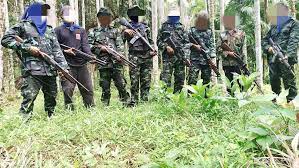As Tanintharyi region has suffered increasing armed struggle of people, the resistance forces have gained foothold in urban areas of Tanintharyi region over more than two and half years, and clashes frequently occurred with the military troops. The report of local research group said that people’s defence forces have controlled many areas of the region, and the military council has also changed its combat strategy.
This interview with Ko Star, an official of Tanintharyi’s People Defence’s Force is about fighting in Tanintharyi region, military’s changes in battle strategy and area control of people’s defence forces.
TLT: Could you talk about armed conflict situations in Tanintharyi region?
Ko Star: PDFs are operating in Dawei district. They are also carrying out their missions near Union Highway in Palaw township of Myeik district, and Bokpyin township.
TLT: Is the military still carrying out offensives? Where are the clashes happening?
Ko Star: They respond to our activities. They carry out offensives in Dawei and Pulaw as our forces become nearer to their control area. They are conducting counter activities.
TLT: Do you mean the military do not carry out offensives anymore?
Ko Star: They carry out offensives in Dawei. No attacks occurred in Myeik and Kawthaung districts, although the military know the locations of PDFs. They take security for VIP trips, mobilization and logistic supplies. However, the military do not intentionally launched attacks.
TLT: What is your view on strategy change of the military?
Ko Star: It is related to their manpower. The military has dispatched majority of its forces to the more conflict-intensifying areas. The number of capable soldiers has declined. We saw many elderly persons in their columns. So, they cannot conduct offensive any more, and are preparing for defensive strategy.
TLT: Which strategy will PDF choose in the future?
Ko Star: We have a one-year plan and battle procedures adopted by the strategists. We are focusing on these steps. We will move forward. Although clashes are not escalating in some townships, we are implementing our objectives. The military is launching attacks in Pulaw, not only to a single area. They are also under attacks in Tanintharyi and other major cities. Resistance forces attacked state departments in Launglone township, and the residence of minister and Hluttaw buildings in Dawei.
TLT: What will be the next step of military council, and how about their ‘four cuts’ strategy?
Ko Star: The military will oppress people in various ways as they are disadvantaging resistance forces. They will arrest and kill people more and more. They are committing these at present, and will do more and more. They are focusing on urban areas, rather than the rural. People in cities will face more hardships in the future. They would not block commodity flows in rural areas, but they will try to cut supply chain for resistance forces. In some cases, they took actions against the suspects.
TLT: What is your message to people in urban areas where clashes are expected to increase in the future
Ko Star: We need information. They military council has set up their security measures in their control areas. We need timely information about the number of their force and geographical situation. We have to rely on these sorts of information in our missions. People living near their camps need to move to other safety. More further it is from them, it is better for the security of people.
TLT: What is your message to people about the existing situation of the military?
Ko Star: A military officer in Pakaryi village, Dawei township, organized a meeting, and he said that they know activities of PDF in this village. They can wander in civilian dresses without arms. They should not shoot the military, and the locals can come back to their home without fear. He highlighted to covey his message to PDF not to attack soldiers. They are stationed in this area by the order. So, they don’t expect battle and any problem.
The military is confronting with the resistance forces throughout the country, and all areas outside their military bases are frontlines for them. They are being fought in many areas, and there is no safety zone for them. Both their manpower and motivation has significantly declined. They don’t want to fight anymore, and hope for peace. The military have disorganized their forces, and they become reluctant to fight.

